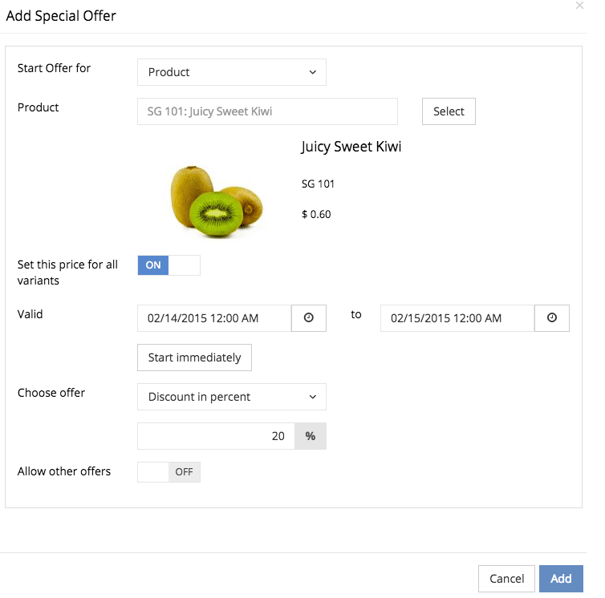Setting up special offers for your customers
Special offers are a perfect marketing tool to promote a product or a line of products for a limited time. In this article, you will find out how to set up a special offer to a specific product or category.
Creating a special offer
To get started, follow the steps below:
- Log in to your Shopgate Admin page.
- Click Marketing from the menu bar, then select Special Offer.

- Here you should see a landing page for Special Offer. Click Create special offer to get started.

- A pop-up window will open. Configure your special offer here and click Add. For more information on how to configure your special offer, please read Understanding the options of a special offer.
IMPORTANT: When adding a special offer for a category, make sure the discounted amount is lower than any product price in the category.


Understanding the options of a special offer
| Start Offer for | Choose to set this offer for a product or a category. |
| Product | Start to type the name of the product or category, and select it from the auto-suggestion. The product or category image as well as some details will now appear underneath. |
| Set this price for all variants (product only) | Turn the option to ON to set this offer to all variants (sizes, colors, etc.) of the product. Leave it on OFF to apply the offer to a selected variant of this product only. |
| Valid | Choose a start and end time, or click Start immediately. |
| Choose offer | Choose to apply a discount in percentage or in dollars. Enter the amount in the text field beneath. |
| Allow other offers | Turn this option to ON to allow this offer to be combined with other offers. Please use caution when using this option - complicated rules will apply. |
Allowing multiple special offers to apply to a product
If you want to allow more than one special offers to be valid for a product, turn option "Allow other offers" to ON in all relevant special offers.
What does it mean to "allow other offers"?
It means that if a product mentioned in one offer is also mentioned in another that runs at the same time, you allow both offers to be considered.
|
For example: Your shoe shop is running two special offers at the same time. Special Offer 1:
Special Offer 2:
In this situation, when both promotions are running, the product "AllStar 37882 Basketball Shoes" can be discounted according to the first or second offer. |
In this example, "Special Offer 2" applies to a category that includes the product in "Special Offer 1." If you want to allow multiple offers to the product in "Special Offer 1," both offers need to have "Allow other offers" enabled.
Which discount is offered if a product is subject to multiple offers?
If a product is included in more than one offer (all with "allow other offers" enabled), one rule will apply: All offers will be compared and the best (cheapest) offer will be used.
|
In the example above: A customer puts a pair of "AllStar 37882 Basketball Shoes" in the shopping cart while both of the following special offers are running:
Now the system will compare which offer is the most beneficial for your customers.
Assume the original price for "AllStar 37882 Basketball Shoes" is $100 before tax. This makes Offer 2 ($80) 5 dollars cheaper than Offer 1 ($85) before tax. In this case, your customers will see $80 as the discounted price (before tax) for this pair of shoes. |
What if a product "allows other offers" in one offer but does "not allow" in another?
There are two important rules that apply to this situation:
- Offers on products and categories are considered equally.
- The first offer that does not "allow other offers" on a product will invalidate all later offers on this product.
If you need an example, consider this table. Make the following assumptions for this example:
- "Product A" belongs to "Category B"
- Offer for "Product A" and offer for "Category B" run at the same time
|
Example
|
Offer "Product A"
|
Offer "Category B"
|
Result
|
|---|---|---|---|
| Example 1 | Allow other offers | Doesn't allow other offers |
|
| Example 2 | Doesn't allow other offers | Allow other offers |
|
| Example 3 | Doesn't allow other offers | Doesn't allow other offers | Product will be discounted based on the first offer created. |
| Example 4 | Allow other offers | Allow other offers | Both offers are considered. The better (cheaper) price is used. |
Frequently Asked Questions
Does an offer of a category apply to sub-categories?
Yes. If a special offer is set to a category, all of its sub-categories will automatically inherit the same discount.
Do tier prices* still apply if a product is on sale in a special offer?
No. As a general rule at the Shopgate system, special offers always have a higher priority than tier prices. In other words, if a special offer (discount) is applied to a product, tier prices will become invalid during the offer period.
*"Tier Pricing" is a new price rule for selected shopping cart systems (currently available for Magento, PrestaShop, Shopware, and Oxid eSales). With tier prices, you can offer discounted price if customers buy more of the same product.
|
Tier pricing examples:
|
Why does a product show an incorrect discount?
If a discount shows up other than the discount you set on a product, it is highly possible that this product is included in another running offer(s).
If you only want to offer a fixed discount on a product, please make sure to uncheck the option "Allow other offers" in the special offer of this product. This will ensure that other special offers cannot interfere with the offer you set for this product.
What should I do if a product shows a negative amount after the discount?
If a product shows a negative amount, please double-check if this product is included in any of the categories that runs a special offer at the moment. If this is the case, you can use any of the following three solutions:
- Set the discount amount to a price that is lower than the price of this product.
- Set the discount in a percentage amount instead.
- Delete the offer for this category. Create an offer for this product only using an appropriate discount, and do not "Allow other offers." Afterward, create the same offer for the category again. This time, the product will be excluded from the category offer.